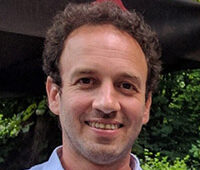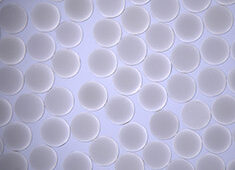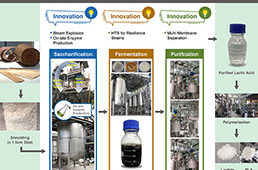An illustration of the researchers’ target protein crystal. Image: Christopher MacDermaid |
Protein design is a technique
that is increasingly valuable to a variety of fields, from biochemistry, to
therapeutics, to materials engineering. University of Pennsylvania
chemists have taken this kind of design a step further; using computational
methods, they have created the first custom-designed protein crystal.
Picking an ambitious
design target with challenging features, the researchers’ success bodes well
for the technique’s use in better understanding proteins’ makeup or using their
self-assembling properties in making new materials with unique properties.
The research was
conducted by professor Jeffrey G. Saven, postdoctoral fellow Christopher J.
Lanci, and graduate student Christopher M. MacDermaid, all of the Department of
Chemistry in Penn’s School of Arts and Sciences. Also contributing to the work
were Seung-gu Kang and Xi Yang, formerly of the chemistry department, and
Rudresh Acharya, Benjamin North, X. Jade Qiu, and William F. DeGrado, formerly
of Penn’s Perelman School of Medicine’s Department of Biochemistry and Biophysics.
The team’s research was
published in Proceedings of the National
Academy of Science.
Proteins are folded
strings of molecular building blocks known as amino acids; their different
functions are determined by their sequences of amino acids and the shapes they
take when folded. As proteins are involved in most biological processes,
determining sequences and structures is crucial to many scientific
undertakings, such as understanding disease mechanisms or designing drugs to
disrupt them.
To determine protein
structures, scientists use crystals, which consist of many copies of a single
protein lined up and stacked together. By irradiating the crystal with powerful
X-rays, they can measure the way the light diffracts off the atoms and piece
together the protein’s overall 3D shape and composition. Most proteins don’t
naturally crystalize, however, and making crystals of sufficient quality to do
diffraction studies is a hit-or-miss process that can take years of painstaking
work.
Protein crystals are also
attractive as a nanoscale building material, as their properties, particularly
their exterior surfaces, are highly customizable. However, bioengineers run
into the same hurdles as crystallographers; making a protein crystal with a
particular structure is a complex, hard-to-predict task.
“People have designed
crystals out of smaller, much less complex molecules than proteins, but protein
design is much more subtle,” Saven said. “It’s a complicated symphony of
intermolecular interactions.”
As accounting for these
many interactions is one of the principal challenges behind designing a protein
crystal, the researchers selected a complicated, honeycomb-shaped target to
show their process could be widely applied.
That process involved
finding the right protein and designing how copies of it will interact with
each other. To tackle the tremendous number of variables involved, the
researchers developed a theoretical method and computer algorithm to search
through potential proteins for ones that could crystalize into their target.
The researchers targeted
a crystal built using a relatively small protein containing a sequence of 26
amino acid positions. The researchers assigned specific amino acids to eight of
the positions, but, with 18 different types of amino acid to choose from for
each of the remaining 18 slots, the algorithm addressed well more than 1022
potential combinations. On top of that, the researchers had to account for
other characteristics, such as the spacing between proteins and their
orientation with respect to one another. These variables multiplied the already
astronomically large number of possibilities, so maximizing the efficiency of
the search was a priority.
“We worked on
synthesizing both of those steps, doing the characterization of structure and
the sequence at the same time,” Saven said. “As we move through this process,
we eliminate things that will never work, such as proteins where atoms overlap
in space or where amino acids don’t fit into a given site. At the same time, we
identify proteins that, as you vary the structure, are likely to yield a
crystal.”
“Combining theory with
recent advances in computer hardware have really allowed us to consider
thousands of candidates, instead of a just a handful,” MacDermaid said.
After a full day of
computation, the researchers’ algorithm produced a handful of promising
candidates. Critically, these proteins had very different sequences from one
another. Even with their computational approach, finding the protein that would
crystalize into their target involved trial and error.
“One reason to consider a
very broad range of candidate proteins is that in nature you have proteins that
are the same across organisms—the same name, structure, and function—but their
sequences are often very different,” Saven said. “Nature finds many different
possible solutions to the same problem, so we wanted to develop methods that
allow us to say something about many disparate possible solutions.”
This approach is
particularly important when considering the eventual applications of a protein
crystal. One sequence may crystalize perfectly but be toxic to cells, making it
difficult to produce or unusable for a biotechnological application. A nontoxic
sequence may form the crystal but only in tiny quantities.
“It’s an important part
of our algorithm that you don’t end up with single sequence and put all of your
eggs in one basket,” Lanci said. “You get a large landscape of possibilities,
improving the odds that you’ll find one that can overcome all the experimental
challenges you can’t control for.”
Beyond presenting
multiple candidates, the computational approach has the advantage of finding
proteins that will produce diffraction-quality crystals. The researchers saw
their candidate proteins begin to crystalize within hours, a process that can
often take weeks or months.
Though they achieved
their goal, the target crystal the researchers produced is just a proof of
concept. The researchers’ algorithm represents an important tool kit for better
understanding the principles behind protein crystallization and the many
variables involved. By adding that understanding back into the algorithm,
researchers will be able to search for candidate proteins more efficiently.
“There’s still much we
don’t know about the interactions that govern crystallization,” Saven said. “With this technique, we can explore what those interactions are or how we
might take an existing protein and engineer those interactions so we get much
better structures.”





